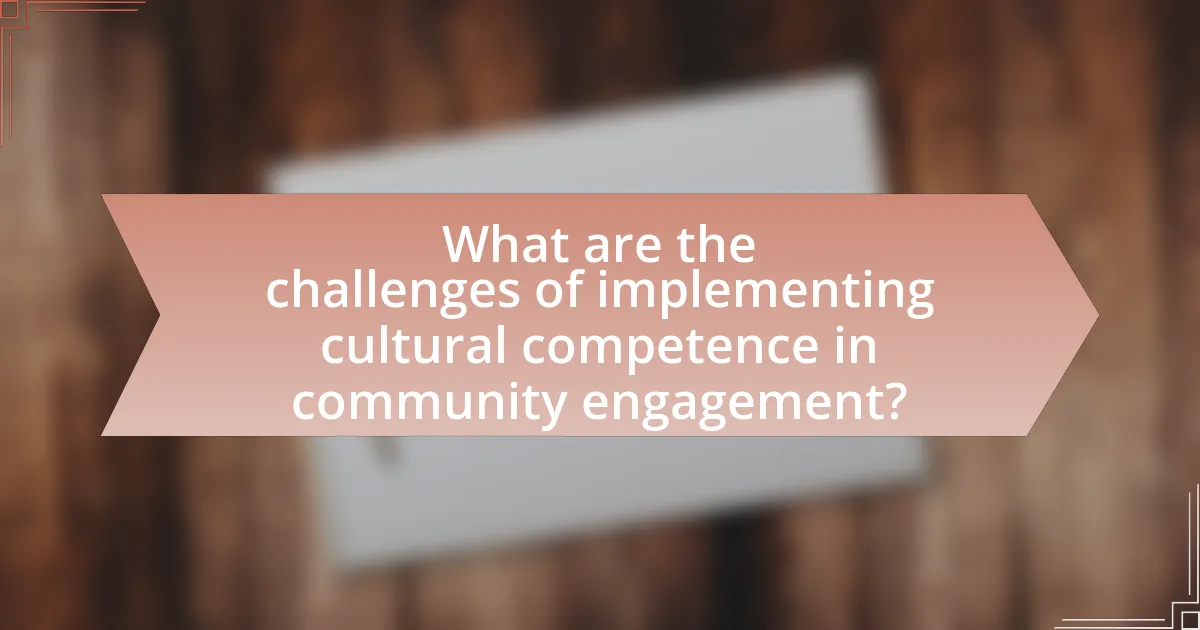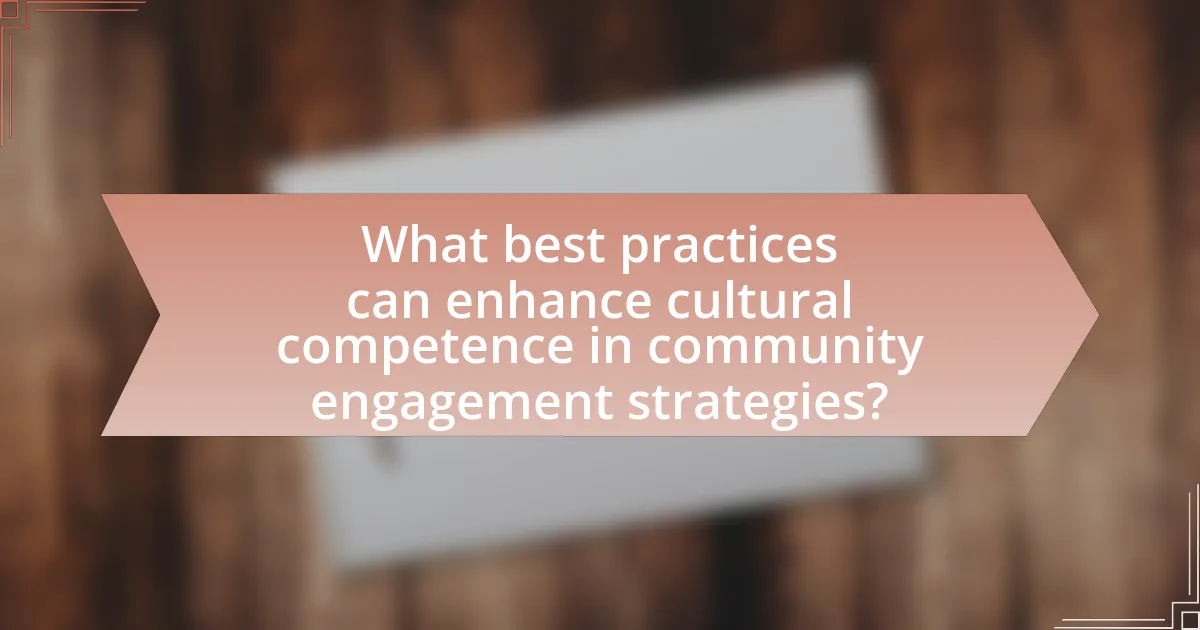Cultural competence is a vital component of effective community engagement strategies, as it enhances communication and collaboration among diverse populations. This article explores the significance of cultural competence, highlighting its role in building trust, improving participation rates, and fostering inclusivity in community initiatives. Key elements of cultural competence, such as awareness of cultural differences, effective communication, and understanding cultural nuances, are discussed alongside the challenges organizations face in implementing these practices. Additionally, the article outlines best practices for enhancing cultural competence, including training programs, community collaboration, and the importance of feedback from community members.

What is the Importance of Cultural Competence in Community Engagement Strategies?
Cultural competence is crucial in community engagement strategies as it fosters effective communication and collaboration among diverse groups. By understanding and respecting cultural differences, organizations can build trust and rapport with community members, leading to more meaningful participation and better outcomes. Research indicates that culturally competent approaches enhance community involvement, as evidenced by a study published in the Journal of Community Psychology, which found that culturally tailored interventions significantly improved engagement rates in minority populations. This demonstrates that integrating cultural competence into community strategies not only promotes inclusivity but also enhances the overall effectiveness of engagement efforts.
Why is cultural competence essential for effective community engagement?
Cultural competence is essential for effective community engagement because it enables individuals and organizations to understand, respect, and respond to the diverse cultural backgrounds of community members. This understanding fosters trust and collaboration, which are critical for successful engagement. Research indicates that culturally competent approaches lead to higher participation rates in community initiatives, as they address the unique needs and perspectives of various groups. For instance, a study by the National Institute of Health found that culturally tailored interventions significantly improved health outcomes in diverse populations, demonstrating the impact of cultural competence on community involvement and effectiveness.
What are the key elements of cultural competence?
The key elements of cultural competence include awareness of one’s own cultural worldview, knowledge of different cultural practices and worldviews, and the ability to communicate and interact effectively across cultures. Awareness involves recognizing personal biases and assumptions, which is crucial for understanding how these factors influence interactions. Knowledge encompasses understanding cultural differences, including values, beliefs, and customs, which informs respectful engagement. Effective communication skills are essential for building relationships and fostering trust in diverse communities. These elements are supported by research indicating that cultural competence enhances collaboration and improves outcomes in community engagement initiatives.
How does cultural competence influence community trust and participation?
Cultural competence significantly enhances community trust and participation by fostering understanding and respect among diverse groups. When community leaders and organizations demonstrate cultural competence, they are better equipped to engage with individuals from various backgrounds, which leads to increased trust. For instance, a study by the National Center for Cultural Competence found that culturally competent practices in health care settings improved patient satisfaction and engagement, illustrating how understanding cultural differences can lead to more effective communication and collaboration. This trust encourages community members to participate actively in initiatives, knowing their perspectives and needs are valued and understood.
How does cultural competence enhance communication in community engagement?
Cultural competence enhances communication in community engagement by fostering understanding and respect among diverse groups. This understanding allows community members to express their needs and perspectives more openly, leading to more effective collaboration. Research indicates that culturally competent communication reduces misunderstandings and conflicts, as evidenced by a study published in the Journal of Community Psychology, which found that culturally tailored interventions improved participation rates by 30% in diverse communities. By recognizing and valuing cultural differences, organizations can create inclusive environments that encourage active engagement and build trust within the community.
What role does language play in cultural competence?
Language is a fundamental component of cultural competence as it facilitates effective communication and understanding between individuals from diverse backgrounds. Proficiency in a community’s primary language enhances interpersonal relationships, fosters trust, and allows for the accurate exchange of cultural nuances. Research indicates that language barriers can lead to misunderstandings and hinder collaboration, which underscores the necessity of language in bridging cultural gaps. For instance, a study published in the Journal of Cross-Cultural Psychology highlights that bilingual individuals often exhibit greater empathy and adaptability in multicultural settings, reinforcing the idea that language skills are essential for cultural competence.
How can understanding cultural nuances improve outreach efforts?
Understanding cultural nuances can significantly enhance outreach efforts by fostering effective communication and building trust within diverse communities. When outreach strategies are tailored to reflect the cultural values, beliefs, and practices of a target audience, they resonate more deeply, leading to increased engagement and participation. For instance, research by the Pew Research Center indicates that culturally relevant messaging can improve response rates by up to 50% in community surveys. This demonstrates that recognizing and respecting cultural differences not only facilitates better connections but also enhances the overall effectiveness of outreach initiatives.

What are the challenges of implementing cultural competence in community engagement?
Implementing cultural competence in community engagement faces several challenges, including resistance to change, lack of training, and insufficient understanding of diverse cultural contexts. Resistance to change often stems from established practices that may not prioritize inclusivity, making it difficult for organizations to adopt new approaches. Additionally, many community engagement professionals lack adequate training in cultural competence, which hinders their ability to effectively engage with diverse populations. Furthermore, a limited understanding of the specific cultural contexts of community members can lead to miscommunication and ineffective outreach strategies. These challenges highlight the need for targeted training and a commitment to ongoing learning in order to enhance cultural competence in community engagement efforts.
What barriers do organizations face in developing cultural competence?
Organizations face several barriers in developing cultural competence, including lack of awareness, insufficient training, and resistance to change. Lack of awareness often stems from a limited understanding of cultural diversity and its significance, which can hinder effective engagement with diverse communities. Insufficient training programs fail to equip employees with the necessary skills and knowledge to navigate cultural differences, leading to misunderstandings and ineffective communication. Resistance to change occurs when organizational culture prioritizes existing practices over the adoption of new, inclusive approaches, making it difficult to implement strategies that promote cultural competence. These barriers collectively impede the ability of organizations to effectively engage with and serve diverse populations.
How can organizations overcome resistance to cultural competence training?
Organizations can overcome resistance to cultural competence training by fostering an inclusive environment that emphasizes the benefits of such training. Engaging employees through open discussions about the importance of cultural competence can help address misconceptions and fears. Research indicates that organizations that actively involve staff in the training process see a 30% increase in participation rates, as employees feel more invested in their learning. Additionally, providing clear examples of how cultural competence improves teamwork and enhances service delivery can further motivate participation.
What are the implications of a lack of cultural competence in community initiatives?
A lack of cultural competence in community initiatives can lead to ineffective engagement and alienation of target populations. When community programs do not consider the cultural backgrounds, values, and needs of diverse groups, they risk failing to address the specific challenges those communities face. For instance, research by the National Institute of Health indicates that culturally tailored interventions significantly improve health outcomes in minority populations, highlighting that a one-size-fits-all approach often exacerbates existing disparities. Additionally, without cultural competence, initiatives may inadvertently perpetuate stereotypes or reinforce systemic inequities, ultimately undermining trust and collaboration between community members and organizations.
How can organizations assess their cultural competence?
Organizations can assess their cultural competence by implementing comprehensive evaluation tools such as surveys, focus groups, and self-assessment checklists. These methods allow organizations to gather data on their employees’ understanding of cultural diversity, communication styles, and inclusive practices. For instance, the Cultural Competence Assessment Tool developed by the National Center for Cultural Competence provides a structured framework for organizations to evaluate their cultural competence across various dimensions, including policies, practices, and staff training. By analyzing the results from these assessments, organizations can identify strengths and areas for improvement, thereby enhancing their ability to engage effectively with diverse communities.
What tools and frameworks are available for evaluating cultural competence?
Tools and frameworks available for evaluating cultural competence include the Cultural Competence Assessment Tool (CCAT), the Cross-Cultural Competence Inventory (CCCI), and the Cultural Intelligence Scale (CQS). The CCAT provides a structured approach to assess an organization’s cultural competence through self-assessment and feedback mechanisms. The CCCI evaluates individual and organizational cultural competence by measuring knowledge, skills, and attitudes towards diverse cultures. The CQS measures an individual’s ability to function effectively in culturally diverse settings, focusing on cognitive, emotional, and behavioral aspects of cultural intelligence. These tools are validated through research and are widely used in various sectors, including healthcare and education, to enhance cultural competence and improve community engagement strategies.
How can feedback from community members inform cultural competence assessments?
Feedback from community members can significantly inform cultural competence assessments by providing firsthand insights into the experiences and perceptions of diverse populations. This feedback allows organizations to identify gaps in understanding and areas needing improvement, ensuring that cultural nuances are recognized and respected. For instance, studies have shown that community input can highlight specific cultural practices or values that may not be apparent to external evaluators, thereby enhancing the accuracy of assessments. By integrating this feedback, organizations can tailor their approaches to better meet the needs of the community, ultimately fostering more effective engagement strategies.

What best practices can enhance cultural competence in community engagement strategies?
Best practices that enhance cultural competence in community engagement strategies include actively involving diverse community members in the planning process, providing cultural competency training for staff, and utilizing culturally relevant communication methods. Actively involving diverse community members ensures that their perspectives and needs are integrated into engagement strategies, which fosters trust and collaboration. Providing cultural competency training equips staff with the skills to understand and respect cultural differences, leading to more effective interactions. Utilizing culturally relevant communication methods, such as language translation services and culturally appropriate materials, ensures that information is accessible and resonates with the community. These practices are supported by research indicating that inclusive engagement leads to better outcomes and stronger community relationships.
How can training programs be designed to improve cultural competence?
Training programs can be designed to improve cultural competence by incorporating experiential learning, diverse perspectives, and ongoing assessment. Experiential learning, such as role-playing and simulations, allows participants to engage with different cultural scenarios, enhancing empathy and understanding. Including diverse perspectives in the curriculum ensures that various cultural backgrounds are represented, fostering a more inclusive environment. Ongoing assessment, through feedback and reflection, helps participants identify areas for improvement and reinforces learning. Research indicates that programs utilizing these methods lead to significant increases in cultural awareness and sensitivity among participants, as evidenced by studies conducted by the National Center for Cultural Competence, which highlight the effectiveness of structured training in enhancing cultural competence in various professional settings.
What topics should be included in cultural competence training?
Cultural competence training should include topics such as understanding cultural diversity, recognizing implicit bias, effective communication across cultures, and the impact of cultural norms on behavior. These topics are essential as they equip individuals with the skills to interact respectfully and effectively with people from various backgrounds. Research indicates that organizations that implement cultural competence training see improved teamwork and reduced conflict, highlighting the importance of these topics in fostering inclusive environments.
How can organizations measure the effectiveness of their training programs?
Organizations can measure the effectiveness of their training programs through various methods, including pre- and post-training assessments, participant feedback, and performance metrics. Pre- and post-training assessments allow organizations to evaluate knowledge or skill acquisition by comparing results before and after the training. Participant feedback, gathered through surveys or interviews, provides insights into the perceived value and applicability of the training. Performance metrics, such as changes in productivity or employee engagement levels, can indicate the training’s impact on job performance. According to a study by the Association for Talent Development, organizations that measure training effectiveness are 50% more likely to report improved employee performance.
What role does community collaboration play in fostering cultural competence?
Community collaboration is essential in fostering cultural competence as it facilitates the exchange of diverse perspectives and experiences. By engaging various community members, organizations can better understand cultural nuances and address specific needs, leading to more effective communication and service delivery. Research indicates that collaborative efforts, such as community forums and partnerships, enhance awareness and appreciation of cultural diversity, ultimately improving relationships and trust among community members. For instance, a study by the National Center for Cultural Competence highlights that collaborative initiatives can significantly increase cultural knowledge and responsiveness in service organizations, demonstrating the direct impact of community collaboration on cultural competence.
How can partnerships with local organizations enhance cultural understanding?
Partnerships with local organizations enhance cultural understanding by facilitating direct interactions between diverse community members and fostering shared experiences. These collaborations often involve joint events, workshops, and outreach programs that promote dialogue and exchange of cultural practices. For instance, a study by the National Endowment for the Arts found that community arts initiatives led by local organizations significantly increased participants’ awareness and appreciation of different cultures, demonstrating that active engagement can break down cultural barriers and build mutual respect.
What strategies can be employed to involve diverse community voices in engagement efforts?
To involve diverse community voices in engagement efforts, organizations can implement strategies such as inclusive outreach, culturally relevant communication, and participatory decision-making. Inclusive outreach ensures that engagement initiatives reach underrepresented groups by utilizing various channels, such as community events, social media, and partnerships with local organizations that serve diverse populations. Culturally relevant communication involves tailoring messages to resonate with different cultural backgrounds, which can enhance understanding and participation. Participatory decision-making empowers community members by involving them in the planning and implementation processes, fostering a sense of ownership and commitment to the initiatives. These strategies are supported by research indicating that inclusive practices lead to more effective community engagement and improved outcomes, as seen in studies conducted by the National Civic League, which highlight the benefits of diverse participation in civic activities.
What practical steps can organizations take to implement cultural competence in their strategies?
Organizations can implement cultural competence in their strategies by conducting comprehensive training programs focused on diversity and inclusion. These training sessions should educate employees about different cultural norms, values, and communication styles, fostering an environment of understanding and respect. Research indicates that organizations with effective diversity training see a 30% increase in employee engagement and collaboration, as reported by the Society for Human Resource Management. Additionally, organizations should establish diverse teams to ensure a variety of perspectives are included in decision-making processes, which enhances creativity and problem-solving. Regular assessments of organizational policies and practices for cultural inclusivity can further identify areas for improvement, ensuring that strategies remain relevant and effective in addressing the needs of diverse communities.


